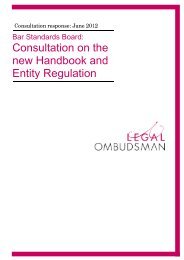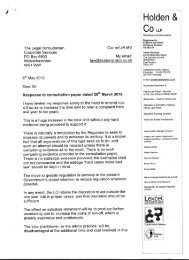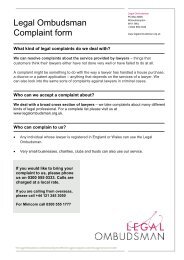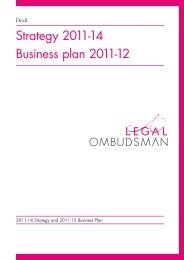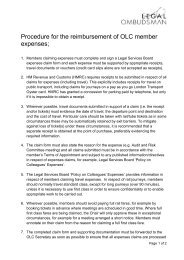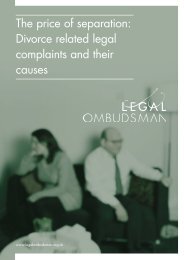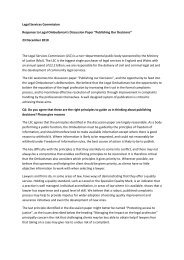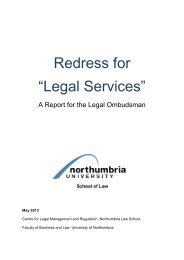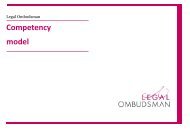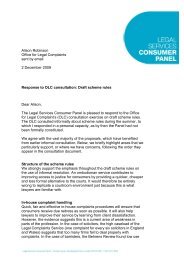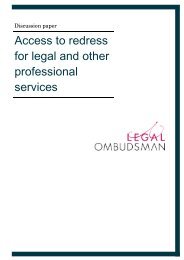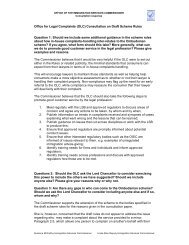Report template A4 office printing - Black - Legal Ombudsman
Report template A4 office printing - Black - Legal Ombudsman
Report template A4 office printing - Black - Legal Ombudsman
Create successful ePaper yourself
Turn your PDF publications into a flip-book with our unique Google optimized e-Paper software.
Q3. Do you have any other thoughts on ways of ensuring ouraccountability, accessibility and responsiveness to equalitygroups?We agree with the views of respondents and understand that we shouldengage directly with stakeholders and be transparent about our equalityand diversity work. Our accessibility will be enhanced by the use of plainEnglish and ensuring that the necessary access arrangements andreasonable adjustments are made.We provide detail on our engagement proposals in our responses to Q7and furtherdetail on our approach to accountability in Q10.Q4. Do you have any other comments you wish to make?Respondents were keen to hear of our plans to work in partnership withthe Solicitors Regulation Authority (SRA), the BSB, and other approvedregulators to further our work around equality and diversity.Our Stakeholder Strategy identifies the desire to develop strongpartnerships with key professional bodies. We also recognise the need tocreate links with other diverse partners to progress our equality agenda.Examples of proposed partnership work include the following: we will utilise the regulators and membership bodies to ensure weare communicating effectively in vehicles such as newsletters,opinion pieces, research publications, case studies and magazineinterviews to communicate with the profession and its users; we will support any specific initiatives that key stakeholders haveto support improvement in customer service, complaint handling,and equality and diversity; we will use existing research data and input into the work thatother organisations are carrying out to capture new equality anddiversity related data on legal service users.Respondents stated that the <strong>Legal</strong> <strong>Ombudsman</strong> should not reinvent thewheel but learn from good practice and existing research undertaken byprofessional bodies and equality group organisations. Respondentsidentified much scope for partnership approach in various areas, such as:- Signposting- Communications- Complaints analysis (risks and concerns)- Training- Consulting and engaging<strong>Legal</strong> <strong>Ombudsman</strong> equality and human rights.
practices and are keen to build on evidence and research alreadyavailable.Q7. What specific suggestions do you have to help us improve theways in which we consult with, and learn from, stakeholder groups?Respondents requested further detail in our proposals on our approachto consultation and engagement with key stakeholders.This has been taken on board and we have included further detail in ourequality priorities and objectives.We are finalising our Stakeholder Strategy, which will focus on ourconsultation and engagement activity. Activities that will support ourequality and diversity commitment will include the following: Work with Citizens Advice (CAB) to enable distribution of ourleaflets to individual branches, and attend and exhibit at the CABannual national conference. Attempt to reach out to „hard to reach‟ communities and othergroups who cater for the needs of minority groups and potentiallyvulnerable users of legal services. Work with key representative and equality groups to raiseawareness of how our works fits alongside the job of theregulators. Identify a range of external groups who cater for diverse users ofthe legal profession to involve them in policy consultation. Wehave established a Stakeholder Advisory Panel, which includesrepresentatives from key legal and consumer groups. The firstmeeting took place on 14 April 2011. Monitor the take-up of consultation and engagement opportunitiesand use this learning to improve the way we work with diversecommunities. Develop a <strong>Legal</strong> <strong>Ombudsman</strong> approach to social media to help usraise awareness with different groups in addition to our work usingtraditional awareness raising methods We have a genuine commitment to engagement. We arecollecting data on customers that use our services and developinga customer satisfaction survey. The results of these will inform thepositive action strategies and shape the kind of engagementactivity we will need to deliver. We will integrate the outcomes ofthe engagement activity into our decision-making.<strong>Legal</strong> <strong>Ombudsman</strong> equality and human rights.
Q8. Do you have any comments on our approach to impactmonitoring?Respondents stated our approach was reasonable. One respondentindicated that clarity over the proposed monitoring of procurement wasneeded. We address this in our response to Q16.Q9. We welcome examples of good practice from elsewhere inrelation to collecting equality data. For example, have we identifiedthe most important sources of evidence relating to equality? Canyou suggest better methods or sources?Organisations, such as the SRA, ILEX and LSB, are currently looking atgathering data and respondents indicated that the <strong>Legal</strong> <strong>Ombudsman</strong>should work with these bodies to further our understanding of legalservice users.Where there are overlaps in data requirements, we would welcome jointopportunities for data gathering to be explored.Q10. Do you have any general comments on our proposals topublish the results of our assessment and monitoring activities?What level of detail would you like to see published?Respondents supported our approach to publish data and be transparentabout the information on which we will base our decisions. Further claritywas, however, sought about the type of information we will want topublish, including where it will be available and at what frequency.Respondents generally agreed with our stance of not collectinginformation on transgender status from our complainants. Somequestioned the value of collecting and reporting on transgender statusbecause of privacy issues, the low proportion of transgender people inthe population and therefore the inability statistically to make use of suchdata. Some thought it was more important to report qualitative data forthis group, and ensure that our policies and practices were trans friendly.As the <strong>Legal</strong> <strong>Ombudsman</strong> is a new service, the volume of activity in thefirst year will focus on collecting data and evidence to help frame thepriorities for forthcoming years.We envisage publishing equality information on a number of areas suchas our equality objectives; employment data, diversity profile ofcomplainants, etc.<strong>Legal</strong> <strong>Ombudsman</strong> equality and human rights.
Some respondents were interested to see more data on the type ofcomplaints we receive. We believe that publication of case studies andgreater information on the causes of complaints would help solicitorsimprove their complaints handling in all areas. This should includecomplaints related to equality and diversity.We will regularly produce case studies that are useful for learningpurposes, by selecting cases that are examples of particular types ofcommon complaints or trends. We will also take care to select a range ofcases that reflect the broad range of work we do, including the areas oflaw, types of complaint and types of lawyer that we deal with. We willalso include cases resolved formally and informally, and where remediesare awarded and where they are not. This will include all complaintsrelated to equality and diversity. It will also be possible to report oncomplainants‟ equality characteristics against the aforementioned data.Q11. Do you have any specific ideas on how we could improveawareness of, and access to, our services?Respondents mentioned we could do this through our partnership andengagement work.We have outlined our plans in these areas in responses to Q4 and Q7.Q12. Do you have any general comments on our approach toemployment data monitoring? Can you suggest any models ofgood practice in employment monitoring and profiling taken fromother bodies? What benchmarks might we use to gauge oureffectiveness as an employer who is committed to equal career anddevelopment opportunities?There was broad agreement that it was good practice to collect andmonitor employment statistics as this helps in workforce planning andidentifying underlying equality issues. Clarity over what HR data we werehoping to collect was requested.We want to be an inclusive and responsive employer. We recogniseestablished best practice across the public sector and have included themonitoring of gender identity, sexual orientation and religion or belief inour employment monitoring.Monitoring will take place in a variety of areas, such as recruitment,retention, promotions, equal pay, flexible working, training, grievances,etc. This level of information has been included in our equality prioritiesand objectives document.<strong>Legal</strong> <strong>Ombudsman</strong> equality and human rights.
We recognise the need to benchmark and suggestions provided byrespondents have been duly noted. When we have sufficient data ofcomparable value, we will make reference to the suggestions made.Respondents also indicated that the <strong>Legal</strong> <strong>Ombudsman</strong> should promoteflexible working and advertise this in the recruitment process, especiallyin job adverts. The <strong>Legal</strong> <strong>Ombudsman</strong> recognises the importance ofhelping its employees manage their work and home life by offeringflexible working arrangements that enable them to balance their workinglife with parental and other caring responsibilities. We offer flexibleworking to all potential and existing employees in line with statutorylegislation.Respondents felt that the <strong>Legal</strong> <strong>Ombudsman</strong> should have properrecognition of trade unions. We are in the process of identifying possibletrade union representation and membership for staff. In addition, wehave recently established an elected Staff Council to support colleaguesin communicating with and being consulted more effectively by theiremployerIt was expressed that a linkage between core competencies andbehavioural competencies was important. This is taken on board andaddressed in our performance management strategy. Equalitycompetencies and objectives will form part of the performanceframework, demonstrating an individual‟s commitment to equality anddiversity.Q13. Can you suggest any models of good and more innovativepractice in the delivery of equality and human rights training?We agree with respondents that we require a mixture of learningopportunities, including a programme of cultural events and externalspeakers which focus on providing an interactive social environment andnew learning experiences.To date, we have delivered induction training, equality data collectiontraining, and workshops on equality impact assessments. We aredelivering workshops on mental health awareness in June 2011. Thiswill be followed by classroom-based equality and diversity training for allstaff in 2011 incorporating a drama based approach, which has more ofan impact in delivering memorable and lasting results. We also aim tointroduce an e-learning training package in 2012 to refresh our learning.<strong>Legal</strong> <strong>Ombudsman</strong> equality and human rights.
Q14. What do you think our role should be in encouraging the legalprofession to adopt and achieve higher standards of equality ofopportunity in their practice?Respondents encouraged the <strong>Legal</strong> <strong>Ombudsman</strong> to work in partnershipwith the Approved Regulators and professional representative bodies todevelop joint initiatives and utilise partner resources and engagementnetworks to promote equality for legal service users. We would welcomesuch an opportunity and have identified our partnership approach in ourStakeholder Strategy.Q15. What is the best way of communicating with the legalprofession about what we are learning?Once again, respondents suggested partnership work would have moreimpact in terms of communicating effectively to the legal profession.A range of communication vehicles were cited by respondents, such asnewsletters, opinion pieces, research publications, case studies, roadshows, webinars, etc. We would welcome all opportunities to work withpartners to jointly maximise communication in this area.Q16. In your experience, what would improve the chances of small,ethnic and other minority businesses winning competitive contractsto supply LeO?One respondent expressed concern about our monitoring arrangementsin procurement and felt that we could be more robust in holdingsuppliers/contractors to account on their equality and diversitycommitment. This might include such things as having equality vetting atthe beginning of the procurement process, establishing the diversity ofany supply chain arrangements, etc.We are committed to making more effective use of our procurementpolicies to promote equality and diversity. As a new organisation, we willcarefully monitor the impact of our procurement policy. We are alreadyseeing some positive outcomes, for example in the use of local suppliers(scanning and on-site cafe providers). Our large scale procurement isnext due in 2012/13, prior to which we will undertake a review of ourprocurement process, incorporating the specific feedback received in theconsultation process, and ensuring it is in line with EU directives.We are keen to work with and learn from partners to improve ourprocurement practices in relation to equality and diversity.<strong>Legal</strong> <strong>Ombudsman</strong> equality and human rights.



